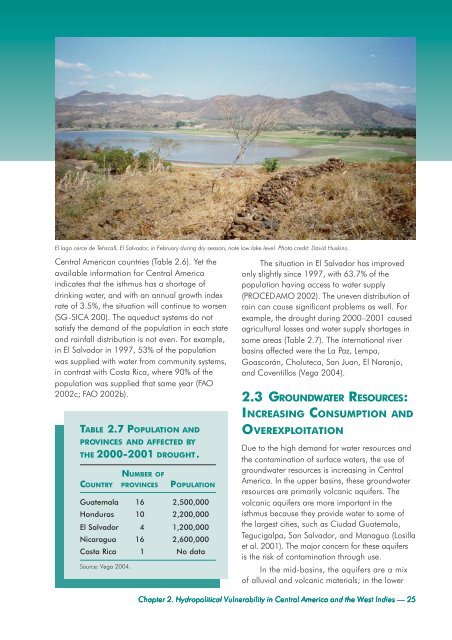Latin America; in English (pdf) - Transboundary Freshwater Dispute ...
Latin America; in English (pdf) - Transboundary Freshwater Dispute ...
Latin America; in English (pdf) - Transboundary Freshwater Dispute ...
You also want an ePaper? Increase the reach of your titles
YUMPU automatically turns print PDFs into web optimized ePapers that Google loves.
El lago cerce de Tehscall, El Salvador, <strong>in</strong> February dur<strong>in</strong>g dry season, note low lake level. Photo credit: David Husk<strong>in</strong>s.<br />
Central <strong>America</strong>n countries (Table 2.6). Yet the<br />
available <strong>in</strong>formation for Central <strong>America</strong><br />
<strong>in</strong>dicates that the isthmus has a shortage of<br />
dr<strong>in</strong>k<strong>in</strong>g water, and with an annual growth <strong>in</strong>dex<br />
rate of 3.5%, the situation will cont<strong>in</strong>ue to worsen<br />
(SG-SICA 200). The aqueduct systems do not<br />
satisfy the demand of the population <strong>in</strong> each state<br />
and ra<strong>in</strong>fall distribution is not even. For example,<br />
<strong>in</strong> El Salvador <strong>in</strong> 1997, 53% of the population<br />
was supplied with water from community systems,<br />
<strong>in</strong> contrast with Costa Rica, where 90% of the<br />
population was supplied that same year (FAO<br />
2002c; FAO 2002b).<br />
TABLE 2.7 POPULATION AND<br />
PROVINCES AND AFFECTED BY<br />
THE 2000-2001 DROUGHT.<br />
NUMBER OF<br />
COUNTRY PROVINCES POPULATION<br />
Guatemala 16 2,500,000<br />
Honduras 10 2,200,000<br />
El Salvador 4 1,200,000<br />
Nicaragua 16 2,600,000<br />
Costa Rica 1 No data<br />
Source: Vega 2004.<br />
The situation <strong>in</strong> El Salvador has improved<br />
only slightly s<strong>in</strong>ce 1997, with 63.7% of the<br />
population hav<strong>in</strong>g access to water supply<br />
(PROCEDAMO 2002). The uneven distribution of<br />
ra<strong>in</strong> can cause significant problems as well. For<br />
example, the drought dur<strong>in</strong>g 2000–2001 caused<br />
agricultural losses and water supply shortages <strong>in</strong><br />
some areas (Table 2.7). The <strong>in</strong>ternational river<br />
bas<strong>in</strong>s affected were the La Paz, Lempa,<br />
Goascorán, Choluteca, San Juan, El Naranjo,<br />
and Coventillos (Vega 2004).<br />
2.3 GROUNDWATER RESOURCES:<br />
INCREASING CONSUMPTION AND<br />
OVEREXPLOITATION<br />
Due to the high demand for water resources and<br />
the contam<strong>in</strong>ation of surface waters, the use of<br />
groundwater resources is <strong>in</strong>creas<strong>in</strong>g <strong>in</strong> Central<br />
<strong>America</strong>. In the upper bas<strong>in</strong>s, these groundwater<br />
resources are primarily volcanic aquifers. The<br />
volcanic aquifers are more important <strong>in</strong> the<br />
isthmus because they provide water to some of<br />
the largest cities, such as Ciudad Guatemala,<br />
Tegucigalpa, San Salvador, and Managua (Losilla<br />
et al. 2001). The major concern for these aquifers<br />
is the risk of contam<strong>in</strong>ation through use.<br />
In the mid-bas<strong>in</strong>s, the aquifers are a mix<br />
of alluvial and volcanic materials; <strong>in</strong> the lower<br />
Chapter 2. Hydropolitical Vulnerability <strong>in</strong> Central <strong>America</strong> and the West Indies — 25
















